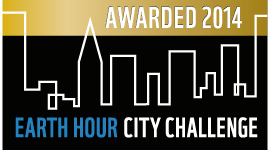Lappeenranta green city
Posted on September, 18 2014
Showcasing stakeholder cooperation
Showcasing stakeholder cooperation
In Lappeenranta, the 2014 National Earth Hour Capital of Finland, a government dedicated to urban sustainable development, a university specialized in green energy, a budding clean-tech cluster, and an enthusiastic public have come together to create the greenest city in the country. Highlights include construction of Finland’s largest and most modern bioenergy plant Kauvo, an internationally awarded Green Campus at Lappeenranta University of Technology (LUT), and development of a solar-powered Green Marina in the harbor.
Keywords: clean-tech cluster, green campus, renewables, bioenergy, stakeholder participation
In the city’s own words, Lappeenranta is a “big small international university city with 72,400 smiling residents,” located in Karelia in Southeastern Finland. After achieving a 21% reduction of GHG emissions in 2011 from a 1990 baseline, the city is on track to reach its goal of a 30% emissions reduction by 2020 for government operations, via its Climate Program and ten action plans (see also Växjö and Sønderborg).
Lappeenranta has integrated sustainable development in all its work, and promotes green energy in a number of ways. The city has: retrofitted its own buildings and launched an energy-saving campaign in the wider community; equipped several schools with environmental programs; built a waste management system with an 80% recycling rate; implemented clean air and water programs; and made its own operations more energy efficient through taking part in WWF´s Green Office Challenge.
Investments in energy and transport
The government of Lappeenranta has managed to implement sustainability goals in the wider community by taking ownership of public services (see also Gainesville). For example, Lappeenranta re-assumed responsibility for organizing the city's public transport after listening to feedback from users, and jumpstarted the new organization by lowering prices, announcing “the new prices will move you!” The use of public transport is now growing, and the city is cooperating with the university in developing the CamBus, a hybrid bus with higher energy efficiency that can reduce bus traffic emissions by 50%.
Through the government-owned utility Lappeenrannan Energia Oy, the city has managed to make major investments in energy efficiency and renewables. In a joint venture, it built Finland’s largest and most modern bioenergy unit, the Kauvo plant, which ensures that 40% of the city’s electricity and more than 50% of its district heating are carbon free. It has also developed a hybrid energy unit for the Lappeenranta Holiday Housing Fair in Rauha, supplying the fair’s buildings with 80% of their energy demand using local sources, including geothermal energy, solar power, and natural gas.
Finland´s largest solar plant
Lappeenranta has Finland’s largest single solar power unit of 220 kW, constructed by LUT on its Green Campus. Another solar plant of similar size is planned jointly by the City of Lappeenranta and the utility, which has also become one of the first energy companies in Finland to start bi-directional electricity sales – enabling owners of solar PVs to sell the surplus energy to the public grid. According to the city, more and more residents in recent years have started to install rooftop solar water heaters and solar panels. Lappeenranta has also started to receive wind-produced electricity to its grid from TuuliMuukko, one of Finland's first major inland wind parks, with 21 megawatts of capacity from seven large wind turbines, in a project whose development involved the university and several local companies.
Research in renewables
LUT is Finland's largest research and education organization in the energy sector, with research in renewables, energy efficiency, recycling, and wastewater purification, and is a major contributor to the city’s green development. It is internationally renowned for its expertise in energy and environmental technology as well as for the unique Green Campus, which won the international Sustainable Campus Excellence Award in 2013. In addition to the solar station, the Green Campus features: a small wind turbine; a smart grid comprising energy storage batteries, a weather station, and electric vehicles; and several measures for saving energy and reducing waste such as car sharing, two-sided printing, and building automation (see also Freiburg).
Green Campus is a test bed not only for potential business ventures, but also for the city of Lappeenranta. Green solutions are meant to spread into the city and turn it into a bigger “green campus.” The Green Marina harbor development is the best example of this joint ambition in the city. It originated as a design competition held in 2012 for local university students, organized by the city in cooperation with the university and other stakeholders. The result is one of the world’s first green leisure-boat harbors, with eco-friendly pilot projects to provide water and energy to the site alongside innovative services and leisure activities, and powered by a new 5.5Kw solar plant.
Clean-tech cluster
LUT has created more than 20 spin-off companies, some of which have joined Lappeenranta’s growing clean-tech cluster of green companies – such as The Switch, an international company producing applications for power generation and energy efficiency (see also San José). Many of these companies are actively engaged in the green development of the city.
Lappeenranta’s strategic goal for 2028 is to become a model city for eco action in which a clean living environment and a zero-waste world are sources of innovative business growth.
References:
Green Energy Showroom, http://www.greenenergyshowroom.fi/en/
The City of Lappeenranta, http://www.lappeenranta.fi/In-English/Main-Page
Lappeenranta University of Technology, http://www.lut.fi/web/en/
carbonn Climate Registry, City Climate Report: Lappeenranta, http://citiesclimateregistry.org/index.php?id=313&tx_datareport_pi1%5Buid%5D=468
Text by: Martin Jacobson
Related links









